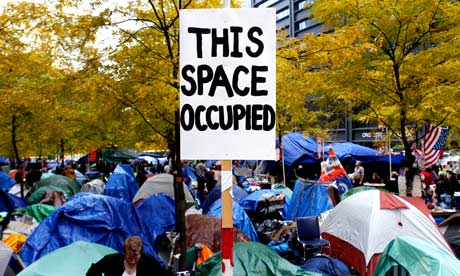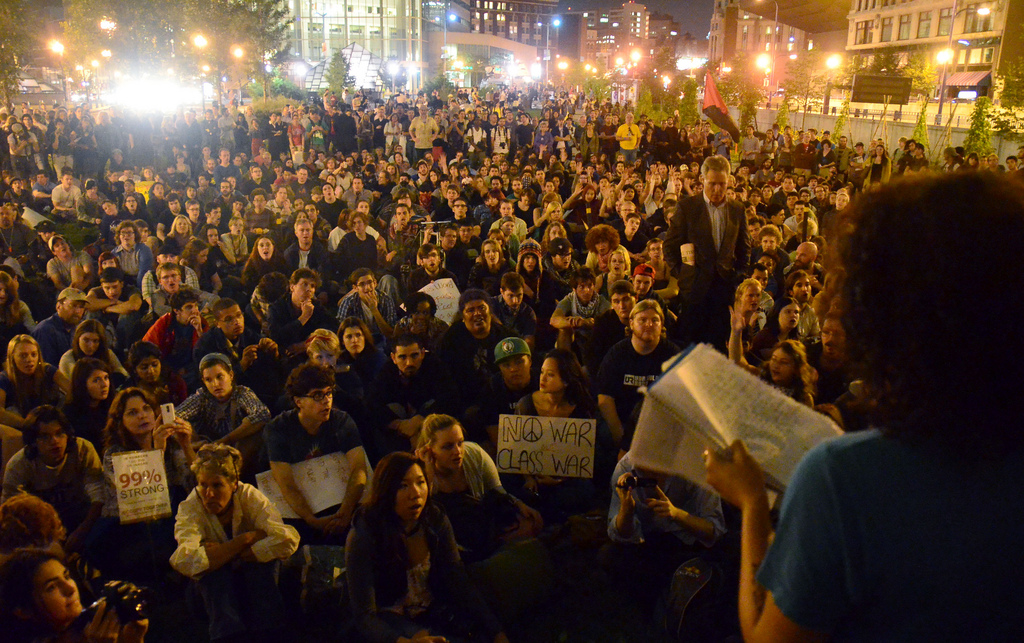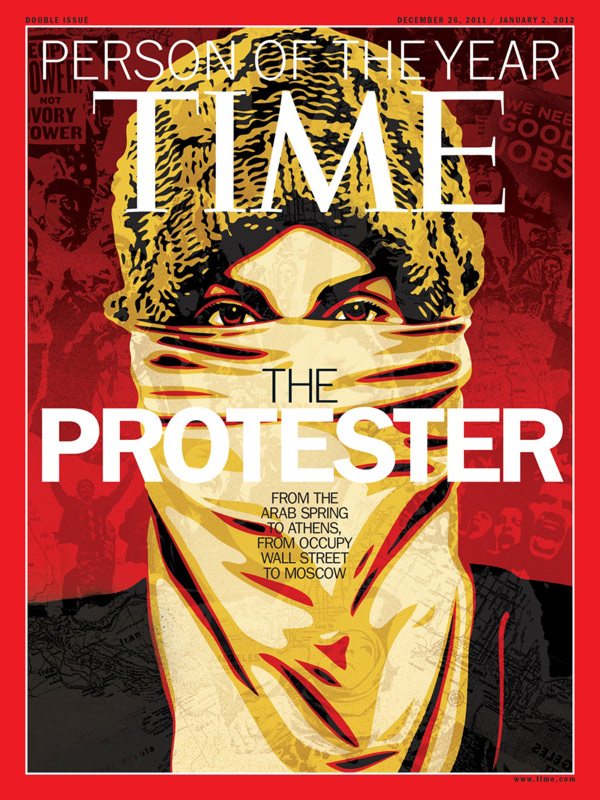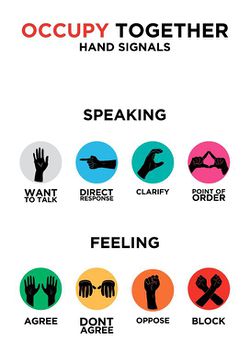The Medium is the Masses: Embodied Amplification, Urban Occupation
 Friday, August 21, 2015 at 12:38PM
Friday, August 21, 2015 at 12:38PM Katherine Kelp-Stebbins and Allison M. Schifani
[ PDF Version ]
In September 2011, groups of community organizers, activists, and others gathered to protest economic inequality in New York City’s Zuccotti Park under the banner of "Occupy Wall Street." The crowd that formed in the heart of the city’s financial district launched what became a diverse and global movement now known simply as "Occupy." In this initiatory protest, a city ordinance prevented speakers from using electronic amplification systems to address the large audience. Occupiers tactically responded to the absence of microphones or megaphones and speaker systems with an embodied technology known as the people’s mic. In its practice, participants hoping to address the crowds in attendance and at general assemblies (meetings open to all for planning future actions and administering to the daily needs of the occupiers) shouted “mic check,” and the crowd of bodies around them loudly echoed the speaker in response. Thus, they could deliver messages to those out of earshot in the occupied spaces.
This phenomenon spread well beyond the boundaries of Zuccotti Park to Occupy protests in Oakland, Los Angeles, Detroit, Portland, and elsewhere. The people’s mic became so emblematic and—we will argue—intrinsic to the objectives of occupation that participants used it instead of electronic amplification in many places where such communication systems were legal and available. Our project is to articulate the specific context and stakes involved in Occupy’s tactical use of embodied technology. How does the people’s mic represent a playful intervention into the bureaucratic and biopolitical policing of public space? How can we read its potential for practices of resistance?
Over the course of the following article, we will look at the people’s mic as a means by which protesters reasserted the political power of public space and embodied communal communication. In Commonwealth, Michael Hardt and Antonio Negri question “whether only hegemonic, unified subjects or also horizontally organized multiplicities are capable of political action.”[1] We argue that the people’s mic demonstrates precisely the possibility of horizontally-organized political action, in which mediated communication is performed through bodily imbrication of sender, receiver, and message. In this case, the medium materializes the horizontality of the Occupy movement. The people’s mic provides a politically charged instantiation of the medium as message, reinforcing the communality of Occupy aims through the sonic expanse of speaker voices. The same bodies that constitute the Occupy movement, in terms of the physical occupation of space, also comprise the technology of the movement’s political communication. In our attempt to constellate theoretical approaches to a still-emerging practice, we begin by looking at the people’s mic in terms of technology and then go on to imagine its relevance to urban space.

Figure 1
We take the human microphone as our object because it serves as a pragmatic intervention embodying what Deleuze and Guattari call an assemblage and what Michel de Certeau refers to as a tactic. Though the term assemblage is appropriately difficult to pin down in Deleuze and Guattari’s work, their introduction to A Thousand Plateaus offers this gloss: “An increase in the dimensions of a multiplicity that necessarily changes in nature as it expands its connections.”[2] One possible way to rephrase this: by connecting potential nodes in a communication network, the people's mic amplifies sound as it also expands the capacities of both message and medium, charging and changing bodies and space.
As de Certeau describes it in The Practice of Everyday Life, a tactic—as opposed to a strategy—lacks its “own place,” or a “view of the whole;” it is determined by “the absence of power just as a strategy is organized by the postulation of power.”[3] In the Occupy movement in particular, de Certeau’s notion of a strategy, which articulates “proper place[s]” to each element, describes the bureaucratic policing of public space against which the people’s mic worked.[4] As a tactic, the people’s mic puts a positive political charge on the body as technology. This tactic re-invests public space with bio-technical potential and destabilizes notions of instantaneous communication and hyper-abstraction that have been part and parcel of the neoliberalization of the global economy. The users of the people’s mic are hybrid, even cyborg; as such, these users can help us understand what is at stake in the intersection of space, politics, bodies, and technologies in the contemporary moment.
The people’s mic resists easy categorization as a communication technology because it cannot be comfortably situated as a contemporary "new" media object. It is unplugged, as it were. It is both a potentially liberatory and a residual technology. While its horizontal network of senders and receivers recalls the potentiality of radio technology that Walter Benjamin[5] and Bertolt Brecht theorized, the constraints of the people’s mic differ in terms of material substrates, infrastructures, and locations. The people’s mic cannot operate without the embodied participation of proximal listeners. These participants are further constrained by interruption, background noise, and the limits of the human body, as well as by the architecture of the spaces of occupation.
Of course, any particular speech given via the people’s mic can be relayed further still—remediated by media technologies such as radio or webcast. However, every remediation decontextualizes and even deterritorializes the message from the spaces that bodies are physically occupying. Removed from the occupied space, the communication of the message of the multitude to the multitude by the multitude becomes abstracted and in its abstraction, effectively immunized. In biopolitical terms, immunity stands in opposition to community as that which exonerates one from the obligation of radically communitized life and protects one from the risk of contagion the community presents.[6]
The people’s mic manifests the openness of community: the transmission of a message depends upon bodies open to external elements. Participating in the people’s mic exemplifies the risk that community poses: individuality dismantled and subsumed by collectivity. On the other hand, watching the people’s mic via YouTube in the safety of one’s own space immunizes the viewer from the threat communicated in and through the people’s mic. What the process of remediation can still communicate is the practice and vernacular of the tactical technology itself, wholly accessible to any vocal crowd anywhere. This means that remediation, even as it distorts the message, can still be positively activated. It also indicates once more that the people’s mic functions as an assemblage: it does not operate in isolated or analog form but rather is tied up in feedback with digital technology, urban architecture, and biological forms.
In the case of the people’s mic, the act of communicating at all is the political coming into being of the movement’s message in localized space. The use of the communal voice of the people to communicate the singular voices of the people indicates a technological fulfillment of the polyvocal, rhizomatic political ideology of the movement (insofar as it has one).

Figure 2
This has important implications for the Occupy movement in the history of political demonstration. While the people’s mic differs from other aural elements of protest, it did emerge from a long-standing and diverse collection of practices that capitalized on orality and sound. One exemplary tactic leveraged throughout Latin America and in Canada is the ‘caserolazo’ or “casserole," in which protesters bang on pots and pans to create a din.[7] There is also a long history of music and chanting in public protest.[8]
Regardless, the people’s mic and the related consensus-building strategies that occupiers employed were the focus of much theoretical and popular interest in the protests. As Ryan Ruby explains in The Journal of Occupied Studies: “While the consensus process, amplified at Zuccotti by the People’s Mic, has long been a feature of anti-hierarchical movements — its origins have been variously traced to anarchist groups, anti-nuclear activism, Quaker churches, and tribes in Madagascar — it is probably fair to say that it first came to mainstream attention in this country with Occupy.”[9] Important to our interests in this article, the co-constituency of the consensus process and the people’s mic engages the bodies’ listening and speaking capacities. It does this in ways that work in concert with—indeed, are co-productive with—the movement’s messages. American political movements are often narrativized around specific leaders, icons, and orators who serve as mouthpieces for crowds that are only partially visible.[10] Yet, while many intellectual and cultural luminaries attended and spoke at Occupy protests around the country, the popular representation of this movement (and the many movements which closely preceded and followed it, including The Arab Spring) remains the anonymous crowd.

Figure 3
The people’s mic is instrumental to forming the feedback loops involved in the authorless image of the movement. The traditional loudspeaker[11] or microphone distinguishes a speaker from everyone else. The masses in this more common scenario are only intelligible as noise or callback. By subverting this distinction, the people’s mic at once makes the speaker (she who speaks) and speaker (that which amplifies her words) literally and dynamically co-constituent and gives a tactical vocabulary to the masses for further implementation in any setting. In this sense, the technology of the people’s mic is not only the apparatus for amplification; it is also a technology that extends the communality of the movement through embodiment.
 Figure 4
Figure 4
Additionally, practice indicates that the merging of medium and message was the direct aim of the people’s mic. Mainstream media coverage has drawn a distinction between the people’s mic and ‘mic-checking,’ the practice of protesters interrupting, for example, speeches by Karl Rove, Michelle Bachmann, and Barack Obama by yelling “mic check” into the crowd while the speakers attempted to talk into a traditional microphone. Seemingly distinct in tactical aims—the people’s mic is a technology for spreading messages, while mic checks are devoid of message and aim to disrupt the signal a single speaker sends at a podium—we can understand these as one technology employed differently for different aims and contexts. The people’s mic shares the potential Brecht saw in radio: every body can be both sender and receiver:
[R]adio is one-sided when it should be two. It is purely an apparatus for distribution, for mere sharing out. So here is a positive suggestion: change this apparatus over from distribution to communication. The radio would be the finest possible communication apparatus in public life, a vast network of pipes. That is to say, it would be if it knew how to receive as well as to transmit, how to let the listener speak as well as hear, how to bring him into a relationship instead of isolating him. On this principle the radio should step out of the supply business and organize its listeners as suppliers.[12]
Every member of the crowd and the crowd itself as the technology of the people’s mic has the potential for communication as well as the disruption of communication.[13]
Karl Rove notoriously responded to mic-checkers by telling them, “If you believe in the right, the First Amendment, of free speech, then you demonstrate it by shutting up and waiting until the Q&A session, lining up behind the mic and asking your question.”
It is especially convenient that the man with access to the microphone can define free speech for those without such access and accessories. Positioning the people as the amplification technology works against authoritarian single-sender messages and one-way communication. In any given instantiation of the people’s mic, protesters or any others within earshot can choose to remain silent and refuse to amplify and thus further transmit a given speaker’s signal. In that case, the signal would dissolve into the ether—it cannot occupy space. Mic-checking unveils the lack of popular access to political speech and underlines the asymmetrical relationship between speaker and audience in traditional amplification systems.
The people’s mic technology, because it is necessarily embodied by its users, also highlights spatiality as a contested political playing field. It draws attention to space itself as a material substrate of communication. Furthermore, in its Occupy instantiations, the people’s mic reveals the boundaries between public and private space as well as the potential porosity of such boundaries. It puts a particular common technology in the hands of anyone who is able to speak. Voice and space, while not universally accessible, can be very widely mobilized. Nomadic, liquid power and its discontents have not given up the street, the park, the passage, or the port. But, as architecture and media theorist Scott McQuire writes:
If urban space has historically been defined by the relation between static structures and mobile subjects, this dichotomy is fast giving way to hybrid spatialities characterized by dynamic flows which not only dissolve the fixity of traditional modes of spatial enclosure, but problematize the unified presence of the subject traversing their contours.[14]
The use of digital technology by urban subjects has created even more complex hybrid structures of bodies, transmissions, transits, and transgressions. While Howard Rheingold and others imagine the possibility for “smart mobs”—technologically enabled political action networks[15]—the Occupy movement also highlights the importance of bodies in space and time.
Such materialized spatial and aural actions avoid the fetishization of a global connectivity that dissolves the value of shared and public places. Paul Virilio and David Harvey,[16] among others, have argued that space/time compression in the "global city" erodes and erases traditional political relationships once built via physical proximity. Global connectivity may provide an infrastructure through which so many Occupy movements could rapidly proliferate in so many cities. Yet, this connectivity is also harvested from proximal, spatial relationships and a shared public sphere. Sound may travel globally via any number of technologies, but it also occupies physical space. Just as radio signals travel through common air, so too do the voices that participate as amplification in the spaces the occupiers appropriate. Harvey and Virilio sagely warned of the potential threats that global connectivity poses; however, the people’s mic has reminded us that local space and propinquity continue to arrest or allow informational flows, and remain contestational sites, as valuable to global capital as they are to its opponents and saboteurs.
As Richard Kim points out in The Nation, “[T]he greatest hidden virtue of the human mic has been the quality that almost every observer has reflexively lamented: it is slow.”[17] The slowness of the message in space calls attention to the material medium of its sending. The people’s mic performs a spatialization of communications technology while simultaneously embodying the communal nature of the airwaves. If the ubiquity of new media has made ‘instantaneity’ appear as truth, the people’s mic reminds us instead that signals travel through space. They require time, even when that time is fractions of fractions of seconds. Given the target of Occupy protests, this rematerialization of time is more than just a comment on contemporary media discourse.
The fiction of instantaneity was intrinsic to the neoliberalization of the global economy. As the popular mythology attests, money in its dematerialized, abstract form can move seamlessly, immediately, even creating itself out of nothing to appear anywhere on a stock market exchange ticker tape. The financial crisis of 2008 dramatically destabilized this myth. The Occupy movement’s insistence on bodies in space, on the material substrate out of which such abstractions are manufactured and onto which their blows fall (quite literally in the case of Occupy),[18] aids us in constructing a clearer cognitive map of global capital.
It should also be clear that the relationship between abstraction and communication—in both the global economy and the instantiation of the people’s mic—is deeply politically charged. It is no coincidence that the people’s mic refuses a "one for the many" ideology or organizing structure in favor of a materially present mass as a sometimes noisy, slow, and jumbled bearer of communal messages. In their use of a particular amplification technology, the occupiers embody both an alternative form of communication and alternative construction of the common. As David Graeber has recently written in his history of debt, there is a complex and long-standing link between capital’s demand for abstraction (moral relationships abstracted as financial relationships) and violence.[19] In using a technology that posits itself as necessarily communal and material, the Occupy protesters indicate the trouble with an abstract economy and the much larger problem of a global sign system that takes such abstractions as their standard stock-in-trade.
The people’s mic may well be an activation of what Hardt and Negri have described as the common—the very thing that can bring the multitude into being as a political force against capital. The multitude is “a multiplicity” of “singular differences,” they write. The people’s mic harvests the multitude’s crowded potential; each distinct voice and its specificity joins in common activation of space and sound.[20] The Occupy movement reinvigorated open urban spaces (some private, some public) as gathering sites with political potential, but it also highlighted the dynamic, mobile possibilities of much broader fields of contemporary space. The people’s mic at any given point of use is only and always coming into form. Every message is an assemblage and its coming into being is co-constituitive of the movement itself.
Let us be clear that our reading of the people’s mic is not nostalgic. We are not looking for a way around or out of contemporary practices that use new technologies—indeed, the Occupy movement clearly understands the value of viral video, live-streaming feeds, Twitter, Face-book, SMS technologies, and the like. Instead, our argument is that "instantaneous" information transmission is never without its material, embodied traces in the first place and activating bodies in the service of protest is still one means by which truth can be spoken to power. As the 2010 suicides at the Foxconn plant in Shenzhen made extraordinarily clear—our technologies start and end with bodies, biological and otherwise, with human bodies, with life.
Notes
[1] Michael Hardt and Antonio Negri, Commonwealth (Cambridge, MA: Harvard University Press, 2009), 173.
[2]Gilles Deleuze and Félix Guattari, A Thousand Plateaus: Capitalism and Schizophrenia, trans. Brian Massumi (Minneapolis: University of Minnesota Press, 1987), 8.
[3] Michel de Certeau, The Practice of Everyday Life, trans. Steven Rendall (Berkeley: University of California Press, 2002), 38.
[4] Ibid.
[5] Walter Benjamin, “Theater and Radio: The Mutual Control of their Education Program,” in Selected Writings 1931-1934, eds. Michael W. Jennings, Howard Eilend, and Gary Smith (Cam-bridge, MA: Harvard University Press, 1999), 583-586.
[6] See esp. Roberto Esposito’s three works on the community/immunity paradigm: Bios: Biopolitics and Philosophy, trans. Timothy Campbell (Minneapolis: University of Minnesota Press, 2008); Communitas: The Origin and Destiny of Community, trans. Timothy Campbell (Stanford, CA: Stanford University Press, 2010); Immunitas: The Protection and Negation of Life, trans. Zakiya Hanafi (Cambridge, UK: Polity, 2011).
[7] See Jonathan Sterne’s writing on the Quebec casseroles during the widespread student protests of 2012. “Quebec’s #casseroles: on participation, percussion and protest,” Sound Studies Blog, 4 June 2012, http://soundstudiesblog.com/2012/06/04/casseroles.
[8] For more on the relationship between music and social movement, see Ron Eyerman and Andrew Jamison, Music and Social Movements: Mobilizing Tradition in the Twentieth Century (Cambridge, UK: Cambridge University Press, 1998).
[9] Ryan Ruby, “On the People’s Mic: Politics in a Post-literate Age,” Journal for Occupied Studies, February 2012, http://occupiedstudies.org/articles/on-the-peoples-mic.html.
[10] For connections between the people’s mic and American traditions of political speech, see Chris Garces, “Preamble to an Ethnography of the People’s Mic,” Somatosphere, 27 October 2011, http://somatosphere.net/2011/10/preamble-to-an-ethnography-of-the-people%E2%80%99s-mic.html.
[11] For more specifically on the loudspeaker and public space, see Sanford Kwinter, Architectures of Time (Cambridge, MA: The MIT Press, 2003), 19-21.
[12] Bertolt Brecht, “The Radio as Apparatus of Communication,” in New media: theories and practices of digitextuality, eds. Anna Everett and John Thornton Caldwell (New York: Routledge, 2003), 30. Cf. Matthew Fuller, who cites Brecht, but shifts the terminology to consider radio as a “media ecology”: Matthew Fuller, Media Ecologies (Cambridge, MA: The MIT Press, 2005), esp. 15-31.
[13]There are instances in which radio’s two-way communicative capacity has indeed been utilized by protesters. One compelling recent example is the use of ham radio in Egypt during the government shutdown of Internet access in late January 2011. See “Old Technology Finds Role in Egyptian Protests,” BBC News, 31 January 2011, http://www.bbc.com/news/technology-12322948. Art Blake has also argued that black populations in the United States utilized CB radio, which he sees as an outgrowth of black oral culture, as part of a response to racial politics in the US from the 1960s on. See “Audible Citizenship and Audiomobility: Race, Technology, and CB Radio,” American Quarterly, 63, no. 3 (2011): 531-553. Our interest here is not to suggest that radio does not have the capacity Brecht saw in it, but rather to show that the embodied technology of the people’s mic activates such potential in distinct ways.
[14]Scott McQuire, The Media City: Media, Architecture and Urban Space (London: Sage, 2008), 132.
[15]Howard Rheingold, Smart Mobs: The Next Social Revolution (Cambridge, MA: Perseus Pub-lishing, 2003).
[16] For connections between the people’s mic and American traditions of political speech, see Chris Garces, “Preamble to an Ethnography of the People’s Mic,” Somatosphere, 27 October 2011, http://somatosphere.net/2011/10/preamble-to-an-ethnography-of-the-people%E2%80%99s-mic.html.
[16] David Harvey, The Condition of Postmodernity: An Enquiry Into the Origins of Cultural Change (Oxford: Blackwell, 1990) and Paul Virilio, “The Third Interval: A Critical Transition,” in Rethinking Technologies, ed. Verena Andermatt Conley (Minneapolis: University of Minnesota Press, 1993), 3-12.
[17] Richard Kim, “We Are All Human Microphones Now,” The Nation, 3 October 2011, http://www.thenation.com/blog/163767/we-are-all-human-microphones-now.
[18]See Jeff Madrick’s article in Harper’s, March 2013, http://harpers.org/archive/2013/03/the-fall-and-rise-of-occupy-wall-street.
[19]David Graeber, Debt: The First 5,000 Years (New York: Melville House, 2012).
[20]Michael Hardt and Antonio Negri, Multitude (New York: Penguin Press, 2004), xiv.
Katherine Kelp-Stebbins is completing her dissertation, Graphic Positioning Systems: World Comics and Radical Literacies, in the Comparative Literature Program at the University of California, Santa Barbara. Her work looks at visual-material rhetorics and the construction of global literatures.
Allison Schifani is the Postdoctoral Scholar in the Digital Humanities at the Baker-Nord Center for the Humanities at Case Western Reserve University in Cleveland, Ohio. She received her Ph.D. from the program in Comparative Literature at the University of California, Santa Barbara. Her work explores urban interventions and new media art.